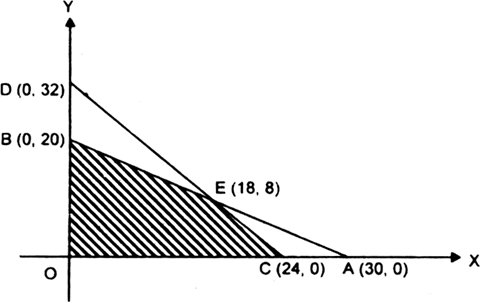 Long Answer Type
Long Answer Type Solve the following linear programming problem graphically:
Minimise Z = 3x + 2y
subject to the constraints x + y ≥ 8, 3x + 5 y ≤ 15, x ≥ 0, y ≥ 0
Solve the following linear programming problem graphically:
Minimise Z = x + y
subject to the constraints x - y ≤ - 1, - x + y ≤ 0, x, y ≥ 0.
A factory makes tennis rackets and cricket bats. A tennis racket takes 1.5 hours of machine time and 3 hours of craftman’s time in its making while a cricket bat takes 3 hours of machine time and 1 hour of craftman’s time. In a day, the factory has the availability of not more than 42 hours of machine time and 24 hours of craftman’s time.
(i) What number of rackets and bats must be made if the factory is to work at full capacity?
(ii) If the profit on a racket and on a bat is Rs 20 and Rs 10 respectively, find the maximum profit of the factory when it works at full capacity.
If a young man rides his motor - cycle at 25 km per hour, he has to spend Rs. 2 per km on petrol ; if he rides it at a faster speed of 40 km per hour, the petrol cost increases to Rs. 5 per km. He has Rs. 100 to spend on petrol and wishes to find what is the maximum distance he can travel within one hour. Express this as a linear programming problem and then solve it.
A firm is engaged in producing two products A and B. Each unit of product A requires two kg of raw material and four labour hours for processing whereas each unit of product B requires three kg of raw material and three hours of labour, of the same type. Every week, the firm has an availability of 60 kg of raw material and 96 labour hours. One unit of product A sold yields Rs. 40 and one unit of product B sold gives Rs. 35 as profit.
Formulate this problem as linear programming problem to determine as to how many units of each of the products should be produced per week so that the firm can earn the maximum profit. Assume that there is no marketing constraints so that all that is produced can be sold.
Let x and y represent the number of units produced per week of the products A and B respectively. Let Z be the profit corresponding to this rate of production. Then
Z = 40 x + 35 y ...(1)
In order to produce these number of units,
total consumption of raw material = 2x + 3y
and total labour hours needed = 4x + 3y
But total raw material available = 60 kg
and total labour hours available = 96
∴ we have,
![]() ...(2)
...(2)
∵ it is not possible to produce negative number of units
∴ x ≥ 0, y ≥ 0 ...(3)
∴ firm’s allocation problem can be put in the following mathematical form:
Find two real numbers x and y such that
2x + 3y ≤ 60
4x + 3y ≤ 96
x ≥ 0, y ≥ 0
and for which the objective function
Z = 40x + 35y
is maximum
Consider a set of rectangular axes OXY in the plane.
It is clear that any point which satisfies x ≥ 0, y ≥ 0 lies in the first quadrant.
Let us draw the graph of
2x + 3y = 60
For x = 0, 3 y = 60 or y = 20
For y = 0, 2 x = 60 or x = 30
∴ line 2x + 3y = 60 meets OX in A (30, 0) and OY in B (0, 20).
Now we draw the graph of 4x + 3y = 96
For x = 0, 3y = 96 or y = 32
For y = 0, 4x = 96 or x = 24
∴ line 4x + 3y = 96 meets OX in C (24, 0) and OY in D (0, 32).
Since feasible region is the region which satisfies all the constraints.
∴ OCEB is the feasible region.
The corner points are O (0, 0), C (24, 0), E (18, 8), B (0, 20).
At O (0, 0), Z = 40 (0) 35 (0) = 0 + 0 = 0
At C (24, 0), Z = 40 (24) + 35 (0) = 960 + 0 = 960
At E (18, 8), Z = 40 (18)+ 35 (8) = 720 + 280 = 1000
At B(0, 20), Z = 40(0) + 35 (20) = 0 + 700 = 700
Here Rs. 1000 is the maximum values of Z and occurs at E (18, 8)
∴ optimal solution is x = 18, y = 8
i.e., 18 units of A and 8 units of B.
